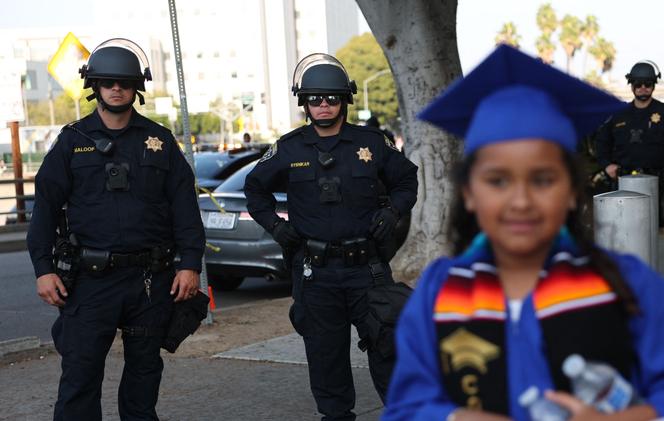


A nighttime curfew was declared in Los Angeles on Tuesday, June 10, as local officials sought to get a handle on protests that Donald Trump claimed were an invasion by a "foreign enemy."
Looting and vandalism has scarred the heart of America's second biggest city as largely peaceful protests over immigration arrests turned ugly after dark. "I have declared a local emergency and issued a curfew for downtown Los Angeles to stop the vandalism, to stop the looting," Mayor Karen Bass told reporters.
One square mile of the city's more-than-500 square mile area will be off-limits between 8 pm and 6 am for everyone apart from residents, journalists and emergency services, she added.
Small-scale and largely peaceful protests − marred by eye-catching acts of violence − began Friday in Los Angeles as anger swelled over ramped up arrests by immigration authorities. At their largest, a few thousand people have taken to the streets, but smaller mobs have used the cover of darkness to set fires, daub graffiti and smash windows. Overnight on Monday, 23 businesses were looted, police said, adding that more than 500 people had been arrested over recent days. Protests have also sprung up in cities around the country, including New York, Atlanta, Chicago and San Francisco.
Trump has ordered 4,000 National Guard to Los Angeles, along with 700 active-duty Marines, in what he has claimed is a necessary escalation to take back control − despite the insistence of local law enforcement that they could handle matters. A military spokeswoman said the soldiers were expected to be on the streets later Tuesday or some time on Wednesday. Their mission will be to guard federal facilities and to accompany "federal officers in immigration enforcement operations in order to provide protection."
The Pentagon said the deployment would cost US taxpayers $134 million. Photographs issued by the Marine Corps showed men in combat fatigues using riot shields to practice crowd control techniques at the Naval Weapons Station Seal Beach.
Two dozen miles North, the sprawling city of Los Angeles spent the day much as it usually does: Tourists thronged Hollywood Boulevard, tens of thousands of children went to school and commuter traffic choked the streets.
But at a military base in North Carolina, Trump was painting a much darker picture. "What you're witnessing in California is a full-blown assault on peace, on public order and national sovereignty, carried out by rioters bearing foreign flags with the aim of continuing a foreign invasion of our country," he told troops at Fort Bragg. "This anarchy will not stand. We will not allow federal agents to be attacked, and we will not allow an American city to be invaded and conquered by a foreign enemy."
California Governor Gavin Newsom, a Democrat who has clashed with the president before, said Trump's shock militarization of the city was the behavior of "a tyrant, not a president": "Sending trained warfighters onto the streets is unprecedented and threatens the very core of our democracy."
In a filing to the US District Court in northern California, Newsom asked for an injunction preventing the use of troops as any kind of policing force, and demanding they be confined to guarding federal buildings. District Judge Charles Breyer scheduled a hearing on the motion − which charges that Trump and Defense Secretary Pete Hegseth have violated the US Constitution − for Thursday.
Trump's use of the military is an "incredibly rare" move for a US president, said Rachel VanLandingham, a professor at Southwestern Law School in Los Angeles and a former US Air Force lieutenant colonel. US law largely prevents the use of the military as a policing force − absent the declaration of an insurrection, which Trump again mused about on Tuesday. Trump "is trying to use emergency declarations to justify bringing in first the National Guard and then mobilizing Marines," said law professor Frank Bowman of the University of Missouri.
